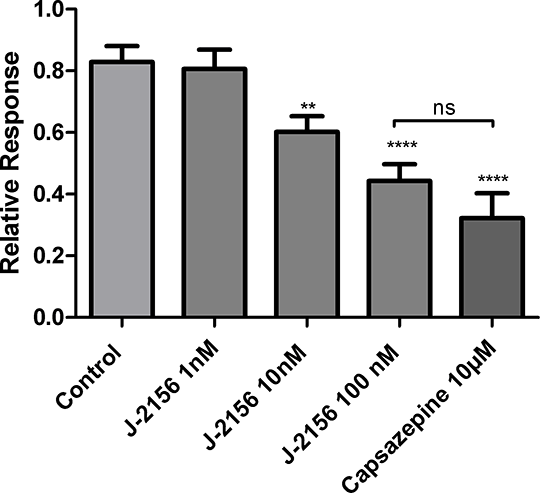Effects of Somatostatin 4 Receptor Activation on Transient Receptor Potential Vanilloid 1 (TPRV1) Currents in Dorsal Root Ganglion Neurons Somatostatin (SST) is a cyclic neuropeptide known to have inhibitory roles in the central nervous system (1). This peptide has shown analgesic properties, which are partially related to the activation of the SSTR4 receptor subtype (2). The precise molecular mechanisms of SSTR4- mediated analgesia have not yet been fully elucidated. This research aimed to investigate a possible analgesic mechanism, showing functional links to the transient receptor potential vanilloid type 1 (TRPV1) within the pain processing pathway. TRPV1 channels are known to have essential roles within nociception (3). Dorsal root ganglion (DRG) neurons were cultured from 6 to 8 week old Wistar Han (Charles River) male rats, and experiments were conducted within 24 hours after plating. Calcium imaging experiments were conducted using the Ca2+-sensitive fluorophore, Fluo-4-AM. The basic protocol used was 2 applications of capsaicin (30 nM, 30 seconds (s)) at timepoints 10 and 450 s. Drugs were applied 240 s after the first application of capsaicin and throught the second. The results are presented as a ratio of the first capsaicin response. Significance was determined by running student unpaired t-test measurements (**P<0.01, ****P<0.0001). A 30 s exposure of cells to 30 nM capsaicin resulted in an induced calcium transient. This effect was concentration-dependently decreased by J-2156. A significant effect was seen at both 10 and 100 nM (P<0.01, P<0.0001 respectively vs control), with a decrease of 27±5% and 45±6% was seen respectively (n=24-53 cells per group). The lowest concentration (1 nM) had no effect. Capsazepine caused a significant decrease in the capsaicin induced calcium transient at 10 µM (P<0.0001 vs control) of 61±8%; (n=29 cells). In conclusion, these data suggest activation of the SSTR4 receptor is able to modulate TRPV1 channel currents in DRG neurons, causing functional inhibition. Thus, the data suggest a potential molecular mechanism through which activation of SSTR4 mediates analgesia. 
(1) Schulz, S et al, Journal of Physiology-Paris, 94: 259-264, 2000 (2) Sandor, K et al, European Journal of Pharmacology, 539: 71-75, 2006 (3) Caterina MJ & Julius D, Annu Rev Neurosci, 24:487-517, 2001 (4) Engstrom, M et al, Journal of Pharmacology and Experimental Therapeutics, 312: 332-338, 2005
|


